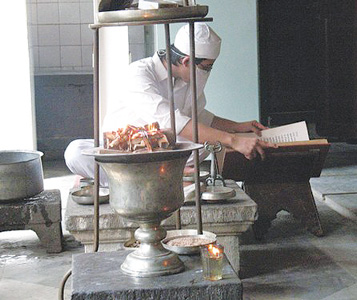 PT: What are the other Baj rituals performed by Priests?
PT: What are the other Baj rituals performed by Priests?
Er. Karanjia: Only priests who have become Navar as well as Maratab can perform the Baj ritual. A Baj ritual consists of reciting prayers which are uttered mutely from commencement to conclusion without any verbal or physical disturbance or interruption. Priests performing the Baj rituals need implements and edible items – importantly the daran (small discs of unleavened wheat flour), pomegranate seeds, ghee and water. The Baj ritual is performed within a perimeter of tiles with lines between them, known as ‘Pavi’. Other essential implements include two ‘karasya’ (mugs made of German Silver); a ‘kahana’ (a large pot made of German Silver filled with water); a ‘fulya’ (small metal bowl); 5 small metal wire chains; 2 chains made of German Silver; a ‘khumcha’ (tray made of German Silver); and a ‘Aesam Boi’, a stone slab for Sukhad and Loban (sandalwood and incense).
Prior to commencing the pertaining Baj ritual, the priest recites the Panj-Tae Baj, using the bundle of five wires, which empowers him with the tenacity and endurance to perform four more Baj rituals without tiring and also the endurance to perform other higher rituals. After concluding the Baj ritual, the priest partakes of a bit of Daran from its edge, alongwith some ghee and pomegranate seeds. He then relinquishes the Baj ceremony.
Prior to constructing a Dokhma, Dokhme Nashini Baj is performed, dedicated to Sarosh Yazad and other Ameshaspands. A Baj ceremony is also performed after the Dokhma is constructed, alongwith the Yajashne, Vendidad, Jashan and other rituals.
The Anushahe Ravaan Ni Baj ritual is performed on all the days when a devotee has the Afarghan and Farokshi rituals performed in memory of a deceased person.
Other Baj rituals performed for various reasons are the Panth Yazad Baj during higher rituals, the Neryoshang Dhaval Baj which was composed by Dastoorane-Dastoor Neryoshang Dhaval and the Agreras Baj.
The most crucial four Baj rituals performed on the morning of the Chahrum day are dedicated to Rashne Yazad and Ashtad Yazad who pass judgement on the departed soul’s deeds, Mino-Ram Yazad who delivers the verdict and the group of Fravashis, the spirits of earlier departed souls, known as Arda Fravash. During the Baj ritual dedicated to Mino-Minoram, an Akhand Siyaav consisting of priestly vestments are offered on a tray. Unless these four Baj rituals are performed, it is impossible for the soul to proceed to its final destination and it lingers in anguish.
The Baj of Siroja Yazad is most vital as Siroja Yazad assimilates all the angels within itself, including Burjor Yazad, Dahm Yazad and Hom Yazad. The Siroja Baj is performed one day before the monthly memorial prayer for the deceased and raying this Baj evokes all the 33 angels.
All the days of the Shahenshahi calendar are dedicated to Yazads and Ameshaspands and a devotee can have the Baj and Afarghan rituals performed on any day in praise of the angel after whom the day is named. Four darans are cooked for the performance of all Baj rituals except for the rituals dedicated to Sarosh Yazad, for whom six darans are placed in the Baj rituals because the Gathas tell us that Sarosh Yazad is the foremost and greatest Yazad who revealed our religion to us. Therefore in the Sarosh Yasht Vadi, the 10th passage (Karda) describes him as ‘Yo Daeno Diso Daenyao’, the Yazad of all Yazads. Another reason given is that Sarosh Yazad accompanies the soul of a deceased person to the Chinwad Bridge through six different spheres or worlds. The ‘Behram Yazad Nu Daran’ is a ritual during which a joyful Baj ritual is also performed, hence the daran in this Baj are sweet.
- તમારી જાત પર વિશ્વાસ રાખો અને લડ્યા વગર હાર ન માનવી જોઈએ, સકારાત્મક વિચારસરણી દરેક સમસ્યાને દૂર કરી શકે છે - 23 November2024
- સંજાણ ડેની 104માં વરસની ઉજવણી - 23 November2024
- 2024 ઈરાનશાહ ઉદવાડા ઉત્સવ આવી ગયો! - 23 November2024
